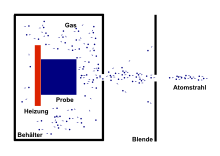Atomic beam
In physics, an atomic beam is a directed stream of neutral atoms of the same chemical element .
generation
If the desired type of atom is not already in gaseous form, atomic beams are often generated by the evaporation of solids or liquids . To do this, the fabric is placed in a container with a heater and a small opening. A panel is attached at a suitable distance behind the opening . By heating to a constant temperature above the boiling point , particles collect in the container at a very similar rate . All atoms that leave the container through the opening and fly through the aperture form the atomic beam. This structure can be refined and expanded as required, e.g. B. by using pumps and other diaphragms to further reduce the number of atoms or the angle at which the atoms fly apart. This arrangement is also called an atomic furnace .
A more complex form of generating atomic beams is sputtering , in which ions are shot at solids in order to detach the neutral atoms. Furthermore, with so-called photodetachment, it is possible to send negatively charged ions, i.e. atoms with one electron too many, vertically through a strong laser beam that detaches the excess electrons from the ions.
application
An important historical experiment is the Stern-Gerlach experiment , in which the directional quantization of angular momentum was demonstrated on a beam of neutral silver atoms .
In laser spectroscopy , atomic beams are used to measure the properties of the atoms. Furthermore, scattering experiments can be carried out by directing an atomic beam onto a material and measuring the deflection of the atoms. Thereby interference patterns also occur, in which the wave character of the atomic beams is shown.
